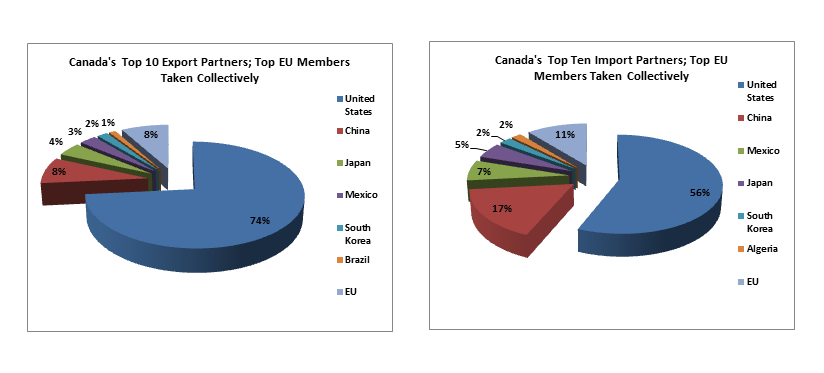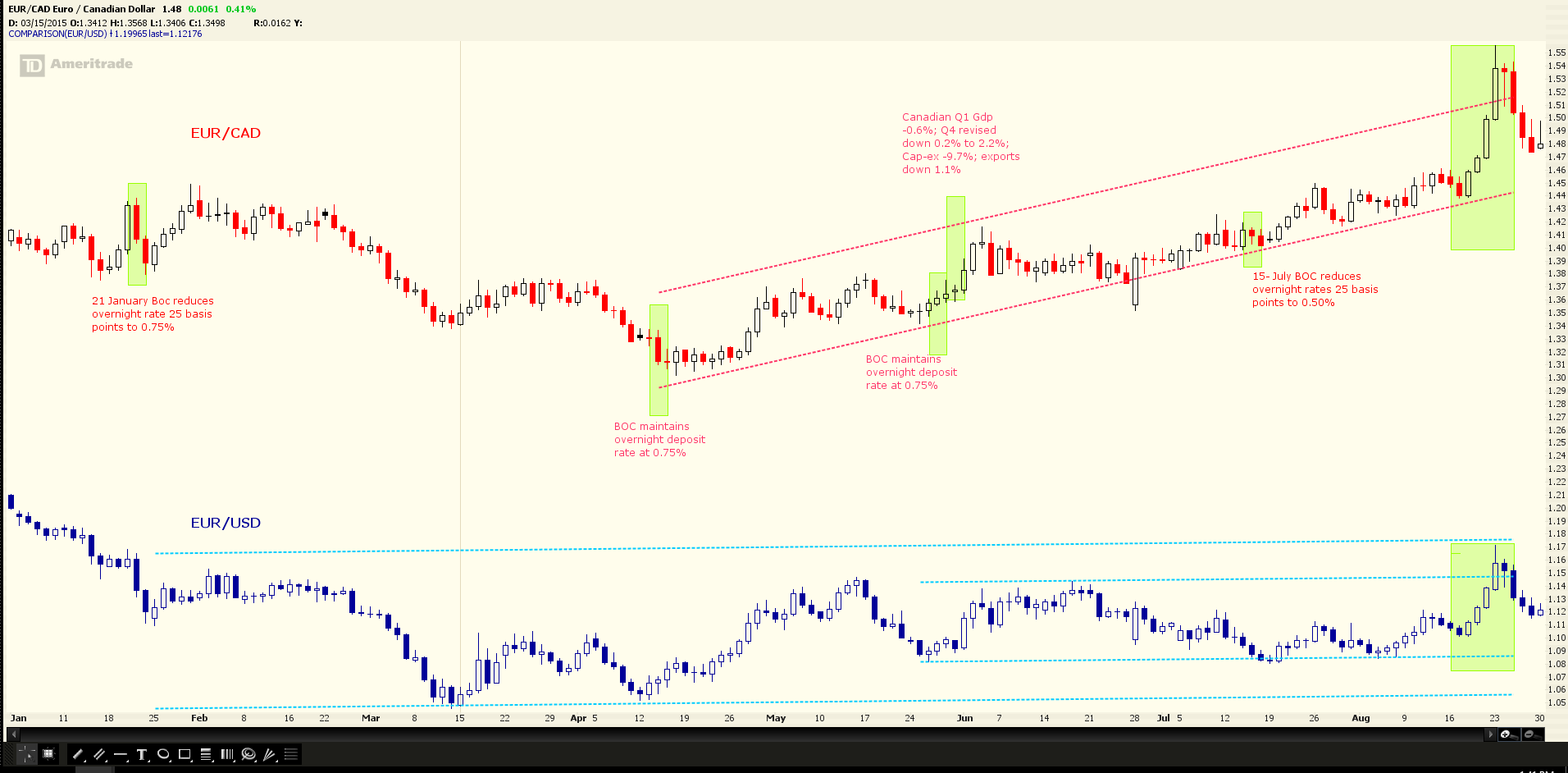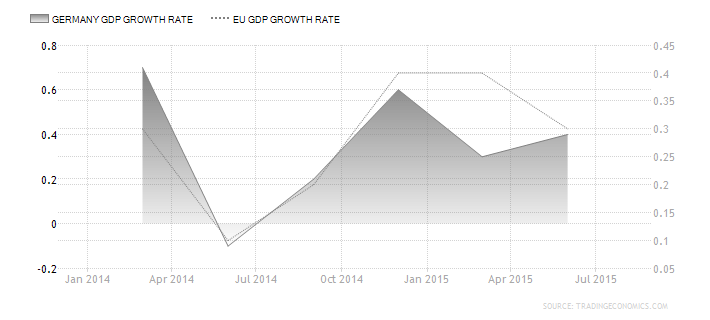Canada’s second and third trade partners are China, at nearly 7% of all exports and Japan at 3.55% of all exports. EU members in the top ten taken collectively account for about 8% of all exports. It’s important to note that the three Asia-Pacific nations listed currently account for approximately 14% of Canada’s exports.
Similarly, Canada’s biggest import partner is the United States accounting for over 45% of imports, followed by China at 13.665 and fellow NAFTA partner, Mexico, third at 5.43% and Japan at 4.07%. When taken collectively, the EU accounts for about 11% of Canadian imports and the top Asia-Pacific nations account for nearly 20% of imports.

Are common strategic or cyclically sensitive commodities or goods exchanged between the EU and Canada? Indeed, there are. These are mostly Crude or Refined Petroleum, Copper, Iron, Aluminum, Nickel, Titanium Ferroalloys and precious and industrial metal scraps and residues. When taken into account along with the commodity excesses in the Asia-Pacific region, Canada’s commodity export trade is bound to weigh on the Canadian economy to a significant degree, even if offset by a reasonably strong US economy.
It’s necessary to turn attention to events in the Asia-Pacific region, in particular, the global asset markets corrections initiated by a sudden deterioration in China’s growth expectations and the devaluation of the Yuan which in turn drove industrial commodity prices lower. The initial reaction was a ‘flight to quality trade’ which strengthened the Euro against other majors. Of particular note is the strengthening of the Euro vs the US Dollar. Because of the close economic and strategic relation between the US and Canada, Canadian dollar trading bears great similarity to US Dollar trading, which is clearly demonstrated in the YTD log chart.

The Canadian dollar has steadily weakened against the Euro since the beginning of April, which coincides with the decline of commodity prices, whereas the USD has traded in a steady channel, which had, in fact, narrowed from about June until the recent global market correction. This seems to indicate stabilization in the Eurozone in spite of the impasse between Greece and the European Commission. Although the Canadian Dollar steadily weakened as the US Dollar remained in a steady channel, there is an unmistakable similarity in the pattern, best exemplified towards the recent reaction to the China devaluation and subsequent asset market readjustments. It’s also worth noting that the tightening of the EUR/USD channel began around the same time EUR/CAD began to weaken.
On 6 April, Bank of Canada Governor Poloz bluntly stated that growth for the remainder of 2015 would be “atrocious”. Although criticized for his ‘wording’, it seems to have proved prophetic. On the other hand, on 5 May the European Commission announced a stabilization of the overall EU economy and increased GDP expectation to 1.5% from 1.3%. Commissioner Pierre Moscovici noted that “...The European economy is enjoying its brightest spring in several years, with the upturn supported by both external factors and policy measures that are beginning to bear fruit...”ii Germany expected 1.9% full year GDP as well as 2% in 2016. It should be noted that Germany is one of Canada’s top trade partners and importer of petroleum as well as Gas Turbines, Iron Ore, Copper Ore, Nickel, Aluminum, Transmissions, Aircraft Parts and Refined Petroleum. Lastly, it’s important to note that Germany ranks 4th behind Japan with a £2.17 trillion economy.

When taking both the US and EU into account, it adds up to about 70% of Canada’s top ten export market whereas about 14% of those top ten account for the Asia-Pacific export market. Hence, as long as the US, UK, Germany and the EUi grow at a moderate pace, Canada will lag, but growth may be far less than ‘atrocious’.
The BOC may have no other choice than to keep the Loonie weak in order to compete with the large oversupply of just about every industrial commodity and the nations which produce them. When viewed as vectors pulling on a central point the magnitude and direction of demand from US and European trade partners, it far exceeds the magnitude of the weaker Asia-Pacific market and in the opposite direction. It’s not unreasonable then to expect the Canadian dollar, with its 0.50% overnight rate, to continue to parallel the US Dollar and revert at least back to the mean vs the Euro once market readjust to reduced global growth expectations.
Recommended Content
Editors’ Picks
EUR/USD retreats to 1.0750, eyes on Fedspeak

EUR/USD stays under modest bearish pressure and trades at around 1.0750 on Wednesday. Hawkish comments from Fed officials help the US Dollar stay resilient and don't allow the pair to stage a rebound.
GBP/USD remains on the defensive around 1.2500 ahead of BoE

The constructive tone in the Greenback maintains the risk complex under pressure on Wednesday, motivating GBP/USD to add to Tuesday's losses and gyrate around the 1.2500 zone prior to the upcoming BoE's interest rate decision.
Gold flirts with $2,320 as USD demand losses steam

Gold struggles to make a decisive move in either direction and moves sideways in a narrow channel above $2,300. The benchmark 10-year US Treasury bond yield clings to modest gains near 4.5% and limits XAU/USD's upside.
SEC vs. Ripple lawsuit sees redacted filing go public, XRP dips to $0.51

Ripple (XRP) dipped to $0.51 low on Wednesday, erasing its gains from earlier this week. The Securities and Exchange Commission (SEC) filing is now public, in its redacted version.
Softer growth, cooler inflation and rate cuts remain on the horizon

Economic growth in the US appears to be in solid shape. Although real GDP growth came in well below consensus expectations, the headline miss was mostly the result of larger-than-anticipated drags from trade and inventories.